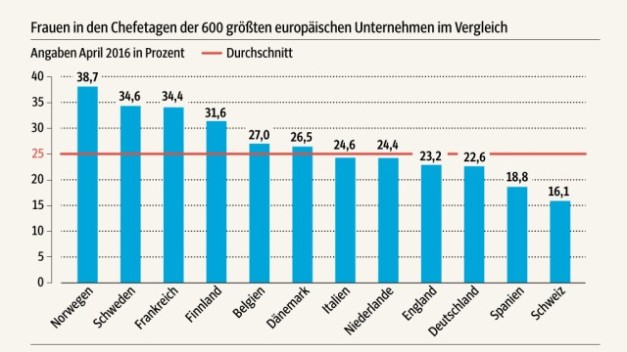Der Wandel in den Führungsebenen von Deutschlands Unternehmen dauert. Andere Länder sind da schon viel weiter.

Von Cerstin Gammelin, Berlin
Frauen in Deutschland gelingt es weiterhin viel zu selten, in die Führungsetagen von Unternehmen aufzusteigen. Die größte europäische Volkswirtschaft liegt beim Frauenanteil in Führungspositionen unverändert unter dem Durchschnitt in Europa. Das geht aus einer Studie der Initiative European Women on Boards (EWoB) hervor, in der die Entwicklung des Anteils weiblicher Führungskräfte in den Verwaltungsräten der 600 größten europäischen Unternehmen untersucht wurde. Das Netzwerk stellte die Ergebnisse am Montag in London vor .
Grundsätzlich stellen die Autoren fest, dass ein genereller Kulturwandel offenbar nicht mehr aufzuhalten ist. Nach dem zwischenzeitlichen Absacken des Frauenanteils in Aufsichtsräten und Vorstandsetagen ist ihre Zahl zuletzt wieder angestiegen. Derzeit sind in Europa durchschnittlich 25 Prozent der Posten in Verwaltungsräten weiblich besetzt. In Deutschland sind 22,6 Prozent der Aufsichtsratsposten von Frauen besetzt, drei von ihnen leiten das Gremium. Noch männlicher geht es in den Vorstandsetagen zu: Nur knapp über sechs Prozent der operativen Unternehmenslenker sind Frauen. Weibliche Vorstandschefs gibt es überhaupt nicht.
Die Zahlen belegen erneut, dass Veränderungen in der deutschen Unternehmenskultur schwierig sind. Um verkrustete Strukturen aufzubrechen, hatte Bundesfamilienministerin Manuela Schwesig (SPD) vor einem Jahr das “Gesetz für die gleichberechtigte Teilhabe von Männern und Frauen an Führungspositionen” durchgesetzt. Sie will einen Anteil von 30 Prozent Frauen in Führungspositionen erreichen . Von diesem Minimalziel ist Deutschland noch weit entfernt.
Andere Länder sind da deutlich weiter. In Schweden sitzen die meisten Frauen in Verwaltungsräten, gefolgt von Norwegen, Belgien, Finnland und Frankreich. Bezogen auf Frauen in großen, gelisteten Konzernen liegt Norwegen unangefochten an der Spitze. Seitdem die Regierung in Oslo im Jahr 2008 eine verbindliche Frauenquote eingeführt hat, steigt der Anteil auf rund 40 Prozent und pendelt seither um diese Marke. In Deutschland, Spanien und in der Schweiz ist das männliche Beharrungsvermögen in Führungspositionen am deutlichsten ausgeprägt.
Die Studie untersuchte nicht nur den Zugang von Frauen in Führungspositionen in den Jahren 2011 bis 2015. Dargestellt sind in der länderübergreifenden Erhebung auch die Entwicklung des Frauenanteils in Ausschüssen, der Weg an die Spitze von Verwaltungsräten, länderspezifische Quoten und die Entlohnung.
Von Frauen geführte Firmen haben einen geringeren Marktwert als die von Männern
Überall geht es langsam voran. Nur vier Prozent aller Aufsichtsratschefposten sind weiblich besetzt, lediglich 16 Prozent aller Rechnungsprüfungsräte. Stagnation gibt es im operativen Geschäft. Im Jahr 2015 waren 3,5 Prozent der Vorstandschefs weiblich – fünf Jahre zuvor waren es drei Prozent gewesen. Von Frauen geführte Unternehmen machen in der Regel weniger Umsatz und haben einen geringeren Marktwert als die Firmen, die Männer lenken.
Gravierend sind die Unterschiede in der Bezahlung. Ein männlicher Vorstandschef in Europa verbuchte im Jahr 2015 durchschnittlich 2,55 Millionen Euro Einkommen. Auf den Konten der Kolleginnen kam ein knappes Drittel weniger an, nämlich 1,95 Millionen Euro. Zwischen den durchschnittlichen Vergütungen männlicher und weiblicher Aufsichtsratschefs lagen immerhin 24 Prozent. “Insgesamt muss noch viel getan werden, bevor Männer und Frauen bezüglich der Top-Positionen auf Augenhöhe sind”, sagte EWoB-Direktor Roger Barker.